Introduction
My dad served in the Royal Navy from February 3, 1948, until October 21, 1955. Among his photos of the time was one of the salvage of HMS Breconshire dated September 1950, that had been attacked and sunk on March 22, 1942, on a convoy from Alexandria to Malta, a distance of around 950 miles.
Over the years, I have received emails from JLB, Des Johnson, Martin Powell and others about the ship which has always deserved its own page. So, here is my history of HMS Breconshire.
The Ship
Breconshire was a converted merchant ship and could carry 5,000 tons of oil. Built by Taikoo Dockyard & Engineering, Hong Kong, she was launched on February 2, 1939, as the MV Breconshire. She was a 9,776-gross register ton (GRT) cargo liner built for the Glen Line. She was taken over by the Royal Navy during World War II as a fast oil tanker as she could reach a speed of 16 mph, sometimes 18mph.
There are stories that the ship had guns painted on its deck to confuse aerial observers, both to make them think the defending forces were more powerful than they were and it was not the merchantman they were looking to sink.
Malta was vital during WWII. Submarines and aircraft based on the isalnd had been doing great work on the enemy's supply lines across the Mediterranean. In the period from May 1 to August 20, 1941 one-third of the ships sailing from Italy to North Africa were sunk. On October 21, Force ‘K’, consisting of the cruisers Aurora and Penelope and the destroyers Lance and Lively, arrived from England. This force was tremndously successful, during October 1941, nearly 63 per cent of the shipping sailing from Italy to Tripoli was sunk in transit. In November, 77 per cent was sunk or badly damaged and only 8,400 tons reached its destination.
Activity such as that carried out by Force ‘K’ used lot of fuel; Breconshire helped supply it and in turn, ships like it were vigorously defended by these ships. On December 15, 1941, the cruisers Aurora and Penelope escorted Breconshire from Alexandria, Egypt to Malta. Six destroyers were despatched from Malta on December 16, and joined the cruisers at daybreak on December 17. That evening several Italian battleships were sighted to the west, and Breconshire was ordered southwards af full speed while the Italians were engaged and chased away. Breconshire was then safely escorted to Malta.
History is sometimes full of anachronisms. Another report of the same engagement says it was the British forces that withdrew, not the Italians.
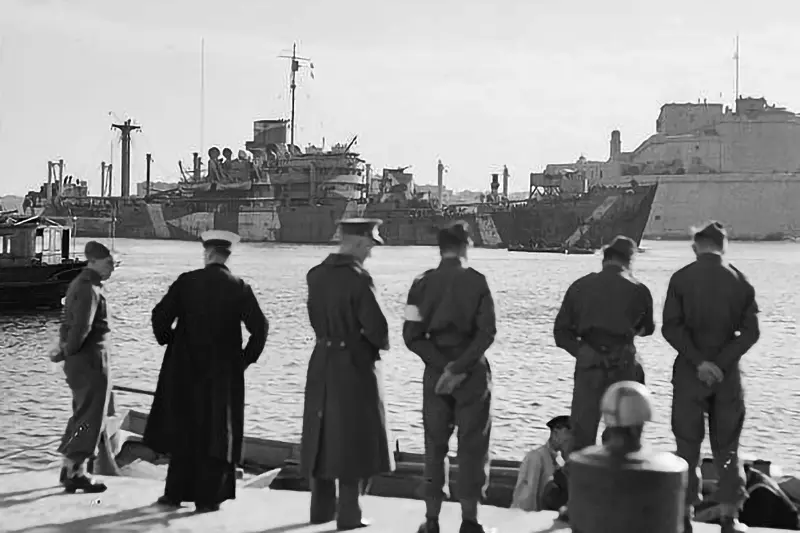
HMS Breconshire entering Grand Harbour, Malta on January 27, 1942
Photo: Imperial War Museums, A7330
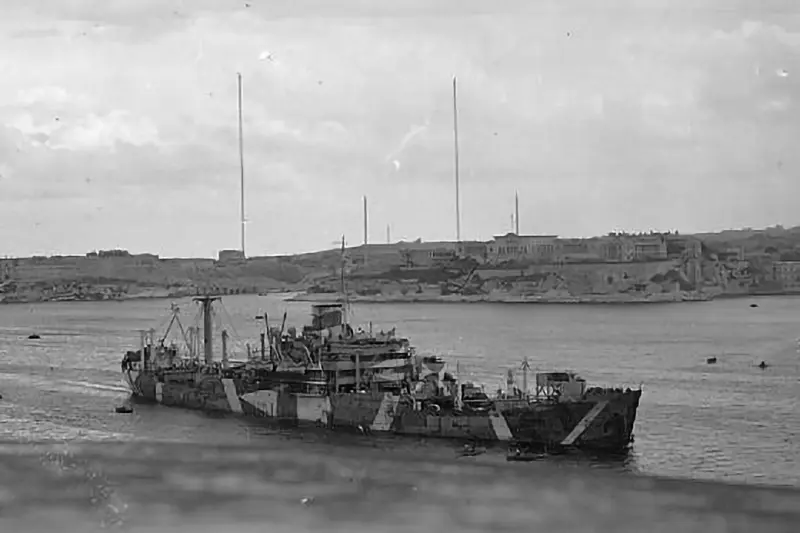
HMS Breconshire at Grand Harbour, Malta
Photo: Imperial War Museums, A6926
Convoys
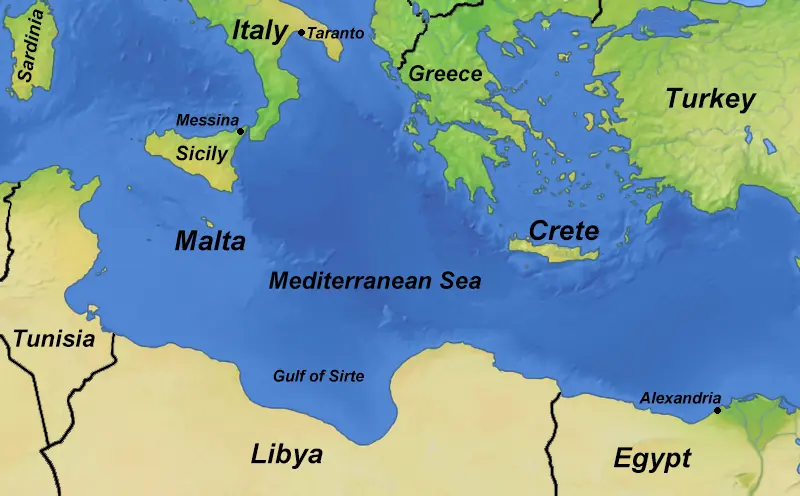
The Mediterranean
Map: Based on Map of the Mediterranean Sea (Wikipedia)
Breconshire took part in many convoys. when looking at the convoys it should be remembered that the frieghters often left and arrived ports separately to each other and often split into smaller groups.
MW 4 - Freighters Breconshire, Clan Ferguson, Clan Macauley, and Mennon, left Alexandria, Egypt for Malta on November 23, 1940, it arrived on November 26. The convoy returned to Alexandria as ME 5A
MW 5½ - Freighters Breconshire and Clan Macauley left Alexandria at 2pm on January 7, 1941, and arrived at Malta on January 10. This convoy was not attacked but Breconshire suffered her first fatality. Her radio operator was killed during an air attack while unloading at Velletta. The left Malta again on February 20, and arrived back in Alexandria on February 22. This convoy was part of Operation Excess which was a series of British supply convoys to Malta, Alexandria and Greece in January 1941.
MD 3 - Breconshire left Alexandria on April 19, 1941, bound for Malta, and arrived on April 21. This convoy was not attacked. Breconshire sailed from Malta on April 28, back to Alexandria.
MW 7 - Departed Alexandria on May 6, 1941 and arrived in Malta on May 9.
MG 1A - Freighters Breconshire, Amerika, Hoegh Hood, Settler Svenor, Talabot and Thermopylae left Malta on July 23, 1941. Breconshire arrived at Gibraltar on July 26. This convoy was heavily attacked.
GM 2 - Freighters Breconshire, Ajax, City of Calcutta, City of Lincoln, Clan Ferguson, Clan MacDonald, Dunedin Star, Imperial Star and Rowallan Castle departed Gibraltar on September 24, 1941 and arrived at Malta on September 28. Breconshire remained at Malta until December 5, left and arrived at Alexandria on December 12.
Breconshire left Alexandria for Malta on December 15, arriving on December 18. This convoy was apparently unnamed.
MF 2 - Breconshire departed Malta on January 6, 1942, for Alexandria, arriving on January 8.
MF 4 - Breconshire left Alexandria on January 24, 1942, arriving at Malta on January 27. This convoy was under constant air attack but little damage was done.
ME 10 - Freighters Breconshire, Ajax, City of Calcutta, and Clan Ferguson departed from Malta on February 13, 1942, and arrived at Alexandria on February 16. This convoy was attacked on February 14 and 15, but was not seriously damaged.
The Convoy MW10
This was the fateful last convoy for HMS Breconshire.
At 7am on March 20, 1942, convoy MW10 consisting of HMS Breconshire, and SSs Clan Campbell, Pampas and Talabot, all carrying cargoes of explosives, ammunition and kerosene, and escorted by HMS Carlisle and six destroyers, Sikh, Zulu, Lively, Hero, Havock and Hasty left Alexandria, Egypt bound for Malta. Stanfing by were the cruisers Cleopatra, Dido, Euryalus and the destroyers Jervis, Kipling, Kelvin and Kingston. Six British submarines took up positions in the Gulf of Taranto and off Messina.
On March 21, the Italian submarines Onice and Platino spot and report seeing the convoy. The Italians deploy Gorizia, Trento, Bande Nere and the destroyers Alpino, Fuciliere, Bersagliere and Lanciere, and the battleship Littorio from Taranto with the destroyers Aviere, Grecale, Ascari, Oriani, later followed by Geniere and Scirocco. The submarines Perla, Acciaio, Galatea, U 73, U 205 and U 431 were deployed and bombers and torpedo planes from the German II. Air Corps and the Italian 4th Air Fleet are brought together. The British submarine P.36 spots and reports the Littorio group. On the British side, the cruiser Penelope and the destroyer Legion are deployed from Malta to join the forces protecting MW10 and join forces with it on March 22.
The Attacks
The convoy was attacked from the air starting at 9:30am on March 22, 1942, At 14:24 the Italian Messina group sights the British covering group and tried in vain to lforce it towards the Littorio. At 16:18, the Littorio approached with the wind increasing strongly and worsening visibility and tried to position itself between the convoy and Malta. Heavy seas and skillful operations by the British using smoke and fog hindered the Italian fire control, so that only Havock and Kingston were seriously damaged by 38cm and 20.3cm hits from Littorio and Trento.
Cleopatra received a 15cm direct hit from Bande Nere, while Euryalus and Lively only suffered minor splinter damage from 3 cm close-range hits from the Littorio. Torpedo attacks by both destroyers were unsuccessful. At 6:58 p.m., the Italians broke off the battle. MW10 headed towards Malta again. On the way back, the Italian force lost the destroyers Scirocco and Lanciere in a storm. The cruiser Trento had to break off its support due to heavy sea damage. Almost all the other Italian and British ships suffered more or less severe storm damage on the way back.
On March 23, the evasive measures the convoy MW10 was forced to make, meant it did not arrive off Malta until after daybreak. Pampas and Talabot made it into harbour safely but the convoy was attacked by bombers of the II. Air Corps. Clan Campbell was sunk 20 nautical miles off Malta. The already badly damaged Kingston was hit by another bomb, but reaches Malta the next day. Breconshire was just eight miles from the harbour when she was hit and stopped by a bomb at 9:20am. HMSs Carlisle and Penelope attempted to tow her but were unable to, so Breconshre was anchored about a mile outside of Marsaxlokk Harbour, in the southeast of the island, where she was further attacked.
SS Clan Campbell was the slowest of the ships and 50 miles away from Malta when she was bombed and sank at 10:30am. HMS Southwold hit a mine and sank. Breconshire was again bombed. The tug Ancient managed to take Breconshire under tow on the night of March 24/25 but she capsized and sank on March 27.
On March 24, Legion ran aground after a close hit and was destroyed on March 26. The two ships that made it to the harbour on March 23, Pampas and Talabot, were attacked again and sunk.The British submarine P.39 is also lost and the cruiser Penelope is damaged. The covering group reached Alexandria on March 24. The next day, Carlisle, Hurworth, Dulverton, Eridge and Beaufort leave Malta and reach Alexandria on March 27. Of the 26,000 tons of cargo carried by MW10 only 5,000 tons were delivered.
In December 2001, I received an email from Mr. Des Johnson whose father-in-law was chief engineer on Breconshire during all its service including the time she was sunk. "She was sunk on March 27, 1942, by a Stuka dive-bombing her, the bomb exploded in the engine room killing many of the crew. A raising attempt occurred in April 1954."
The Aftermath
A notice by the Admiralty, dated September 8, 1942, appeared in The London Gazette of September 4, 1942 saying:
The KING has been graciously pleased to give orders for the following Appointments to the Distinguished Service Order and to approve the following Rewards and Awards:
For gallantry, skill, and seamanship in H.M. Ships Avon Vale, Beaufort, Breconshire, Garlisle, Cleopatra, Dido, Dulverton, Eridge, Euryalus, Havock, Hero, Hurworth, Jervis,], Kelvin, Kingston, Kipling, Legion, Lively, Penelope, Sikh, Southwold, and Zulu in aa brilliant action against strong enemy forces, which were driven off and severely damaged. This-action resulted in the safe passage to Malta of an important Convoy.
After a long list, several pages long, the order continues:
For fortitude, seamanship and endurance in taking Merchantmen through to Malta, in the face of relentless attacks by day and night from enemy submarines, aircraft and surface forces.
The above Appointments form a first short list in recognition of those Merchant Navy Officers whose services in this operation have been brought to notice as most outstanding. Such further Appointments and Awards as His Majesty the King may be graciously pleased to approve will be published shortly.
Whatever cargo that was left on the Breconshire was far too valuable to be abandoned and the Malta: War Diary site has interviews with Maltese workers who needed to get the remaining cargo off of Breconshire after she had capsozed. Len Austin, Foreman of the Dockyard was given the task and described how they drilled a hole into the cargo tanks. The oil was forced out by water entering the tanks from underneath through the now submerged tank air escapes. Once the oil had started flowing they plugged the hole and the Royal Navy took over pumping out the oil with hand-pumps.
Maltese Shipwright Supervisor, Mr. Zammit earned the British Empire Medal by gaining access to other oil tanks on the ship. Mr Austin considered it far too dangerous allow anyone to go into the air spaces between the tanks to drill holes into them, so Mr. Zammit undertook the job himself.
Further holes were cut in the hull to allow access to the engine room and hold and milk, explosives, bombs, timber, and medical supplies were recovered.
Various attempts were made to raise the Breconshire, or at least take a look at what state she was in. (Royal Fleet Auxiliary) RFA Dispenser, along with RFA Plumleaf and AFD 8 arrived in Malta on March 2, 1945 to look at her and ascertain whether she could be lifted.
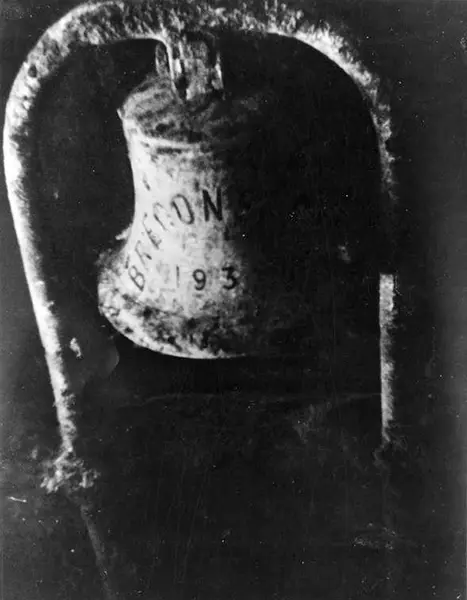
HMS Breconshire's bell in 60ft of water. This photo was taken in 1949.
Photo: Imperial War Museums, A31548
The Salvage
Part of HMS Breconshire's cargo was salvaged in the following months after the attack and in 1950 it was decided to salvage the ship. On August 7, 1950, RFA Dispenser, RFA Sea Salvor and HMS Retriever started the work of raising the ship. She was raised and towed, upsidedown, to Genoa to be broken up.
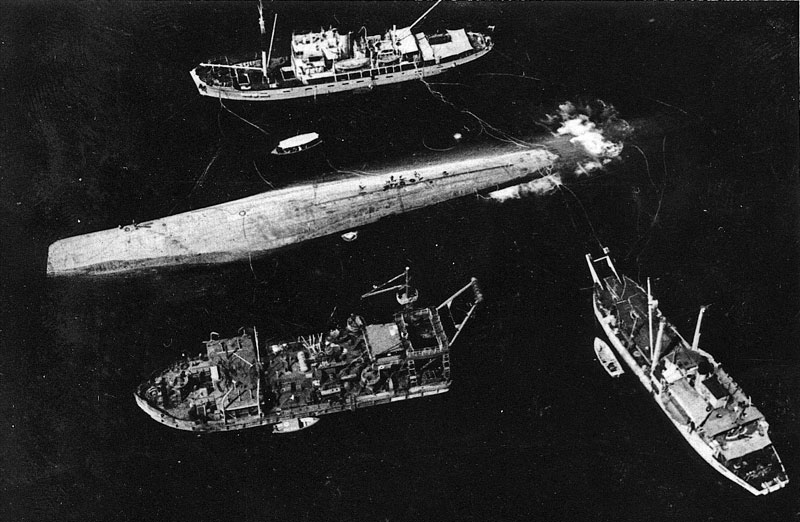
Raising HMS Breconshire, September 1950. Photo from dad's photo albums.
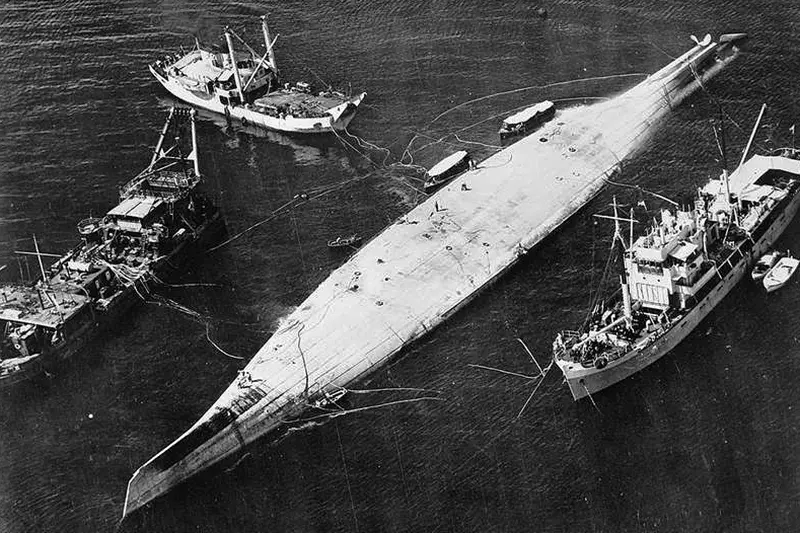
HMS Breconshire being salvaged
Photo: Imperial War Museums, A31714
Several websites mention April 1954 as the date the Breconshire was raised, but I am convinced that it was during August / September 1950. This has caused some confusion...
In August 2004, I received an email from JLB who wrote,
"Reasons for my interest are that in the case of Breconshire, my father who passed away in August 1997, was the electrical engineer on RFA Sea Salvor which was assigned to take part in the salvage of the Breconshire. I am positive that the photo attached to your page in fact shows RFA Sea Salvor (top of picture) during that assignment. It is very evocative for me to think that my father was in fact in that photo when it was taken!
I think one of the other two ships is the Barhill which was as far as I know, also assigned to the task. Interestingly, both these ships were also assigned to salvage the remains of FOG-ALYP - the COMET JET airliner which crashed off the coast of Elba and the salvage of which resulted in the solving of the mystery surrounding the numerous earlier Comet crashes. My father was also involved in that project for which with other crew members of RFA Sea Salvor, he received a commendation from Lord Mountbatten then Admiral of the British Fleet in the Mediterranean.
In the case of HMS Gambia, I recall as a young child in Senglea, Malta where I was born, admiring the many Royal Naval ships that were buoyed in the Grand Harbour in full view right in front of our house. The Gambia was a frequent visitor and with the many other British and international ships, was much admired. Given the visits to that port during the times you mentioned, I theoretically would have "seen" your father as I was certainly there during that period."
In September 2012, I received another email from JLB who is now wondering about the date of April 1954 when the Breconshire was raised.
I am a little puzzled as to whether I have been wrong for the last 50-plus years, in my belief that my father was in fact in Elba at that time, on Sea Salvor with Barhill, involved in the salvage of the Comet air plane - FOG-ALYP. I know ( at least I think I do ) this air plane salvage was begun some time in January 1954 or a little later and I am now wondering whether it was all over by April which would have to be the case, if Sea Salvor and Barhill were indeed at Marsa, in April 1954.
We would be extremely grateful if anyone can confirm the dates of the of the salvage of FOG-ALYP and the Breconshire and any details of that ship, Sea Salvor and Barhill.
Sources & Resources
27 March 1942: Breconshire Sinks – Maltese Dockyard Worker Earns a Medal - Malta: War Diary
1942 March - Chronicle of Naval Warfare 1939-1945
Auction: 22003 - Orders, Decorations and Medals - Spink
Breconshire - Imperial War Museums
First Battle of Sirte - Wikipedia
HMS Breconshire - Wikipedia
Malta Campaign - World War II Database
Old Malta Wreck Raised - YouTube
RFA Dispenser - Historical RFA
Malta convoys - Wikipedia
Operation Excess - Wikipedia
Salvaging of HMS Breconshire - YouTube
Second Battle of Sirte - Wikipedia
The London Gazette - September 4, 1942 - List of awards for convoy duty
The Loss of HMS Neptune - New Zealand Electronic Text Collection
The Supply of Malta 1940 - 1942 - Naval History
Underwater Shots of HMS Breconshire - YouTube